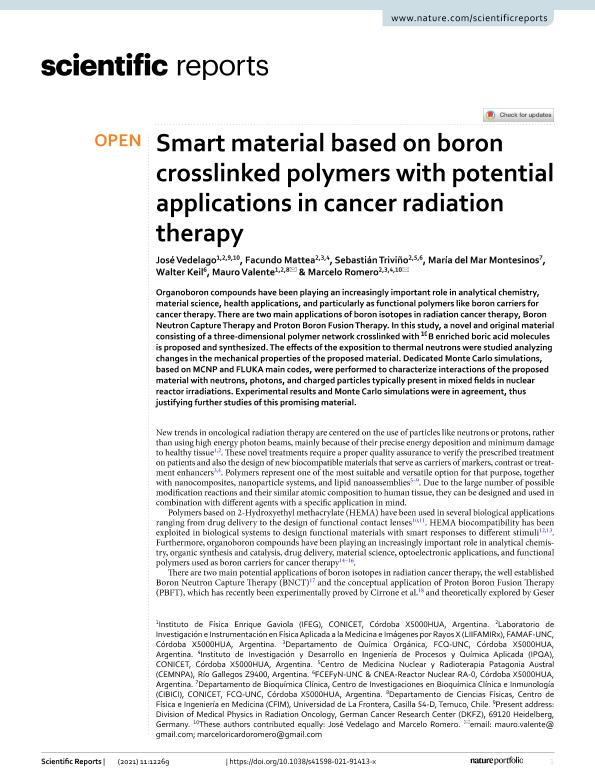Mostrar el registro sencillo del ítem
dc.contributor.author
Scarinci, Ignacio Emanuel

dc.contributor.author
Valente, Mauro Andres

dc.contributor.author
Pérez, Pedro Antonio

dc.date.available
2023-12-01T16:26:16Z
dc.date.issued
2023-12
dc.identifier.citation
Scarinci, Ignacio Emanuel; Valente, Mauro Andres; Pérez, Pedro Antonio; A machine learning-based model for a dose point kernel calculation; Springer; EJNMMI Physics; 10; 1; 12-2023; 1-14
dc.identifier.uri
http://hdl.handle.net/11336/219067
dc.description.abstract
Purpose: Absorbed dose calculation by kernel convolution requires the prior determination of dose point kernels (DPK). This study reports on the design, implementation, and test of a multi-target regressor approach to generate the DPKs for monoenergetic sources and a model to obtain DPKs for beta emitters. Methods: DPK for monoenergetic electron sources were calculated using the FLUKA Monte Carlo (MC) code for many materials of clinical interest and initial energies ranging from 10 to 3000 keV. Regressor Chains (RC) with three different coefficients regularization/shrinkage models were used as base regressors. Electron monoenergetic scaled DPKs (sDPKs) were used to assess the corresponding sDPKs for beta emitters typically used in nuclear medicine, which were compared against reference published data. Finally, the beta emitters sDPK were applied to a patient-specific case calculating the Voxel Dose Kernel (VDK) for a hepatic radioembolization treatment with 90 Y. Results: The three trained machine learning models demonstrated a promising capacity to predict the sDPK for both monoenergetic emissions and beta emitters of clinical interest attaining differences lower than 10 % in the mean average percentage error (MAPE) as compared with previous studies. Furthermore, differences lower than 7 % were obtained for the absorbed dose in patient-specific dosimetry comparing against full stochastic MC calculations. Conclusion: An ML model was developed to assess dosimetry calculations in nuclear medicine. The implemented approach has shown the capacity to accurately predict the sDPK for monoenergetic beta sources in a wide range of energy in different materials. The ML model to calculate the sDPK for beta-emitting radionuclides allowed to obtain VDK useful to achieve reliable patient-specific absorbed dose distributions required short computation times.
dc.format
application/pdf
dc.language.iso
eng
dc.publisher
Springer

dc.rights
info:eu-repo/semantics/openAccess
dc.rights.uri
https://creativecommons.org/licenses/by/2.5/ar/
dc.subject
BETA EMITTERS
dc.subject
DOSE POINT KERNEL
dc.subject
INTERNAL DOSIMETRY
dc.subject
MACHINE LEARNING
dc.subject.classification
Física Nuclear

dc.subject.classification
Ciencias Físicas

dc.subject.classification
CIENCIAS NATURALES Y EXACTAS

dc.title
A machine learning-based model for a dose point kernel calculation
dc.type
info:eu-repo/semantics/article
dc.type
info:ar-repo/semantics/artículo
dc.type
info:eu-repo/semantics/publishedVersion
dc.date.updated
2023-11-28T14:37:32Z
dc.identifier.eissn
2197-7364
dc.journal.volume
10
dc.journal.number
1
dc.journal.pagination
1-14
dc.journal.pais
Alemania

dc.journal.ciudad
Berlín
dc.description.fil
Fil: Scarinci, Ignacio Emanuel. Consejo Nacional de Investigaciones Científicas y Técnicas. Centro Científico Tecnológico Conicet - Córdoba. Instituto de Física Enrique Gaviola. Universidad Nacional de Córdoba. Instituto de Física Enrique Gaviola; Argentina. Universidad Nacional de Córdoba. Facultad de Matemática, Astronomía y Física; Argentina
dc.description.fil
Fil: Valente, Mauro Andres. Consejo Nacional de Investigaciones Científicas y Técnicas. Centro Científico Tecnológico Conicet - Córdoba. Instituto de Física Enrique Gaviola. Universidad Nacional de Córdoba. Instituto de Física Enrique Gaviola; Argentina. Universidad Nacional de Córdoba. Facultad de Matemática, Astronomía y Física; Argentina. Universidad de La Frontera; Chile
dc.description.fil
Fil: Pérez, Pedro Antonio. Consejo Nacional de Investigaciones Científicas y Técnicas. Centro Científico Tecnológico Conicet - Córdoba. Instituto de Física Enrique Gaviola. Universidad Nacional de Córdoba. Instituto de Física Enrique Gaviola; Argentina. Universidad Nacional de Córdoba. Facultad de Matemática, Astronomía y Física; Argentina
dc.journal.title
EJNMMI Physics
dc.relation.alternativeid
info:eu-repo/semantics/altIdentifier/url/https://ejnmmiphys.springeropen.com/articles/10.1186/s40658-023-00560-9
dc.relation.alternativeid
info:eu-repo/semantics/altIdentifier/doi/https://doi.org/10.1186/s40658-023-00560-9
Archivos asociados
